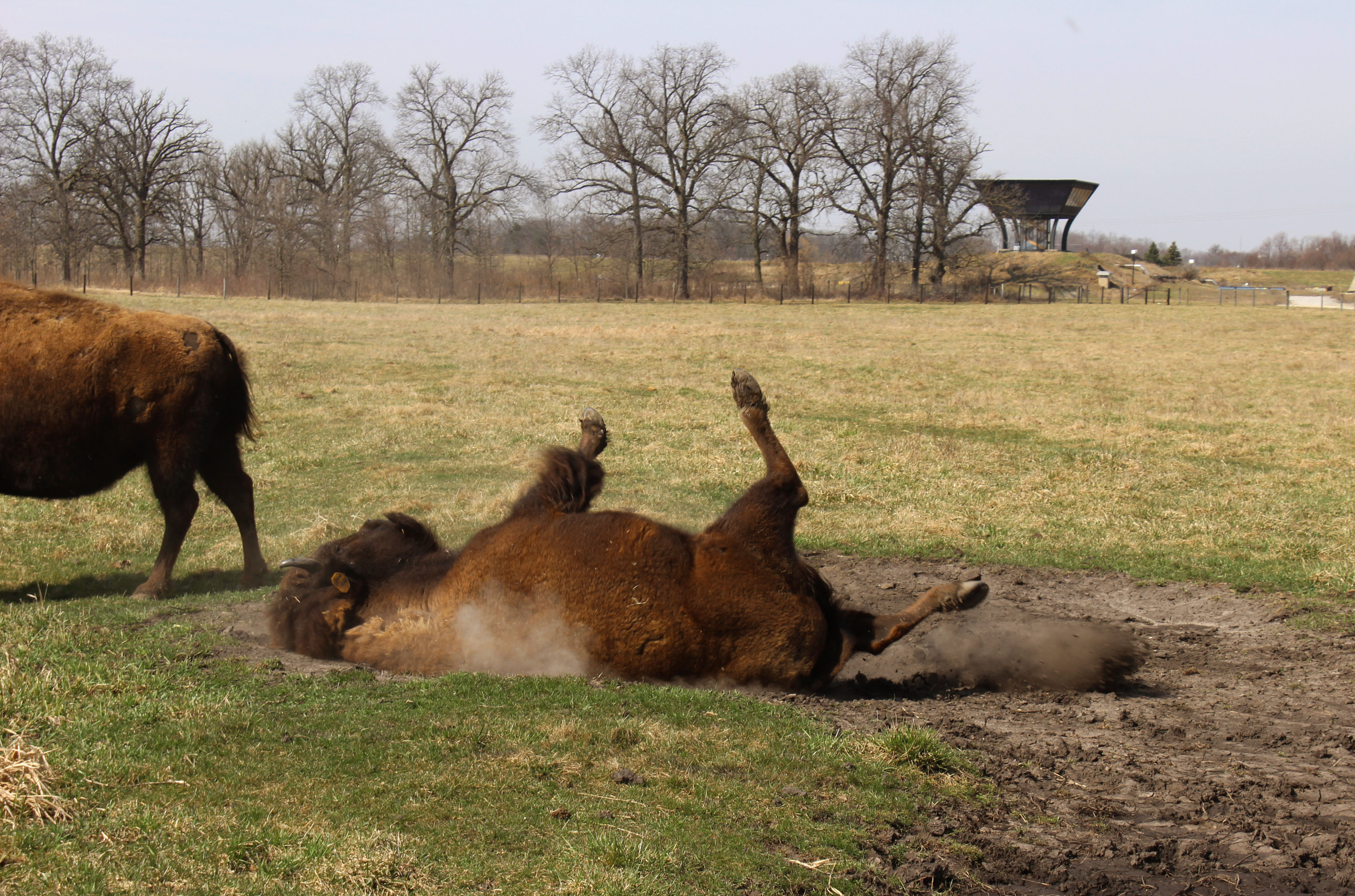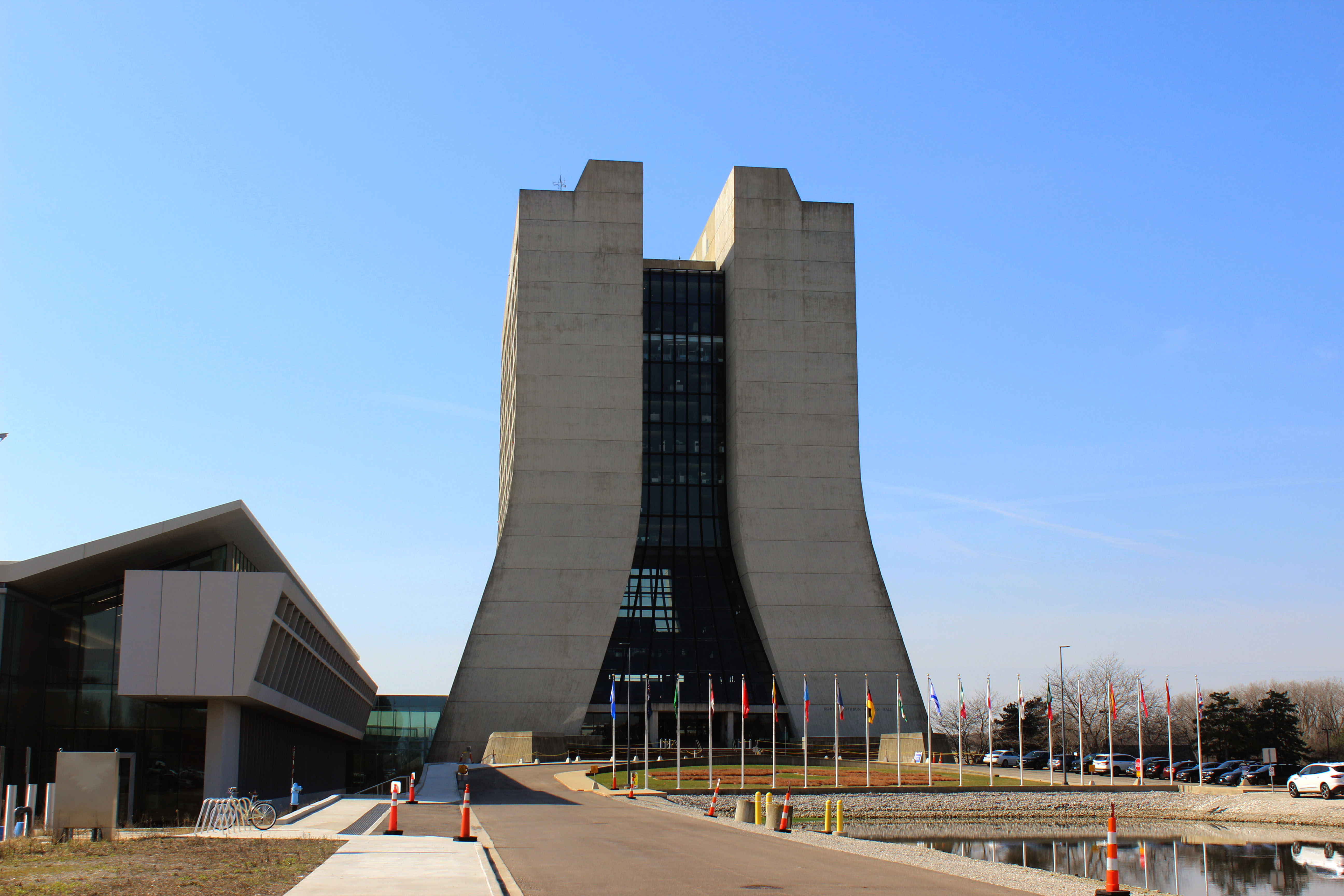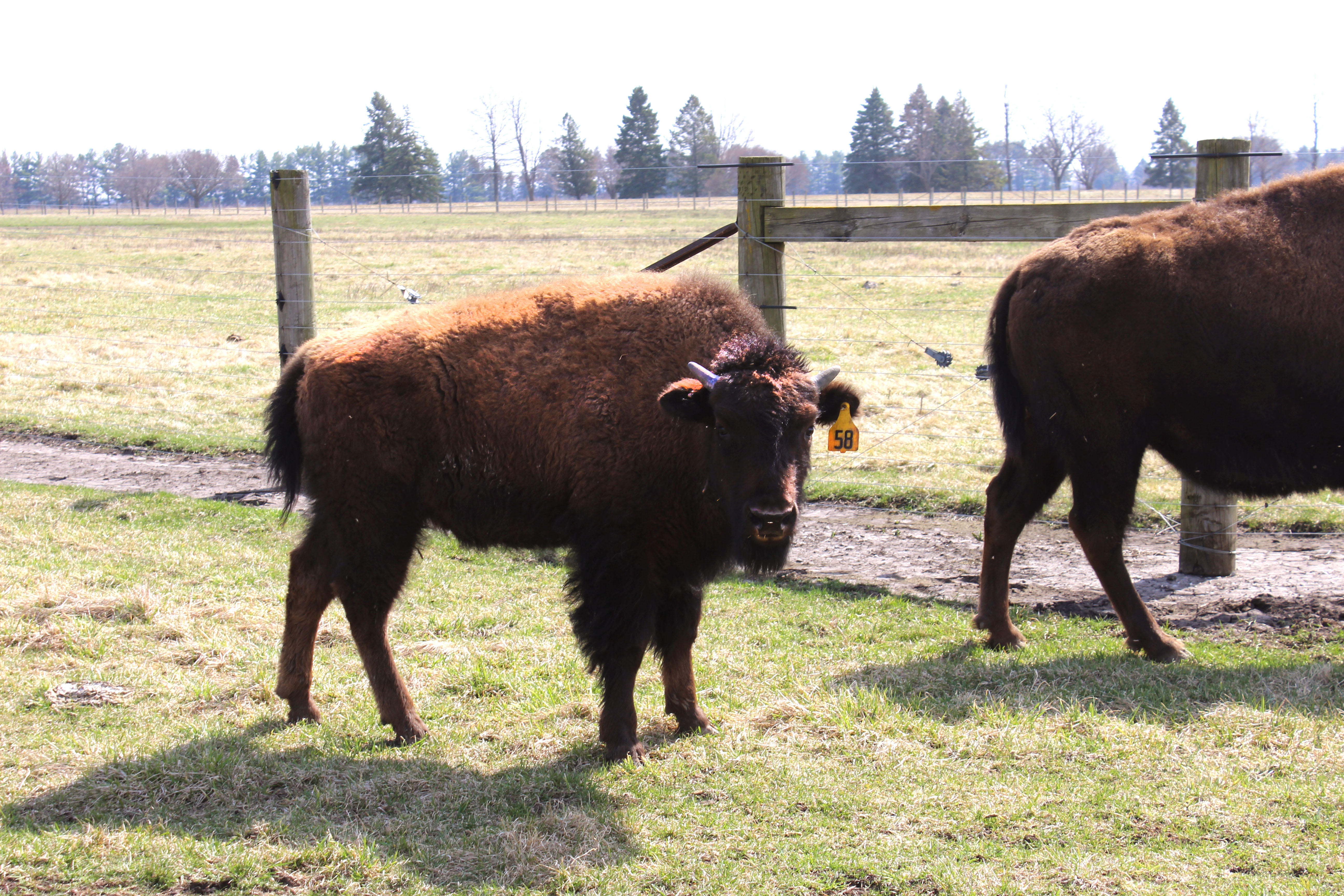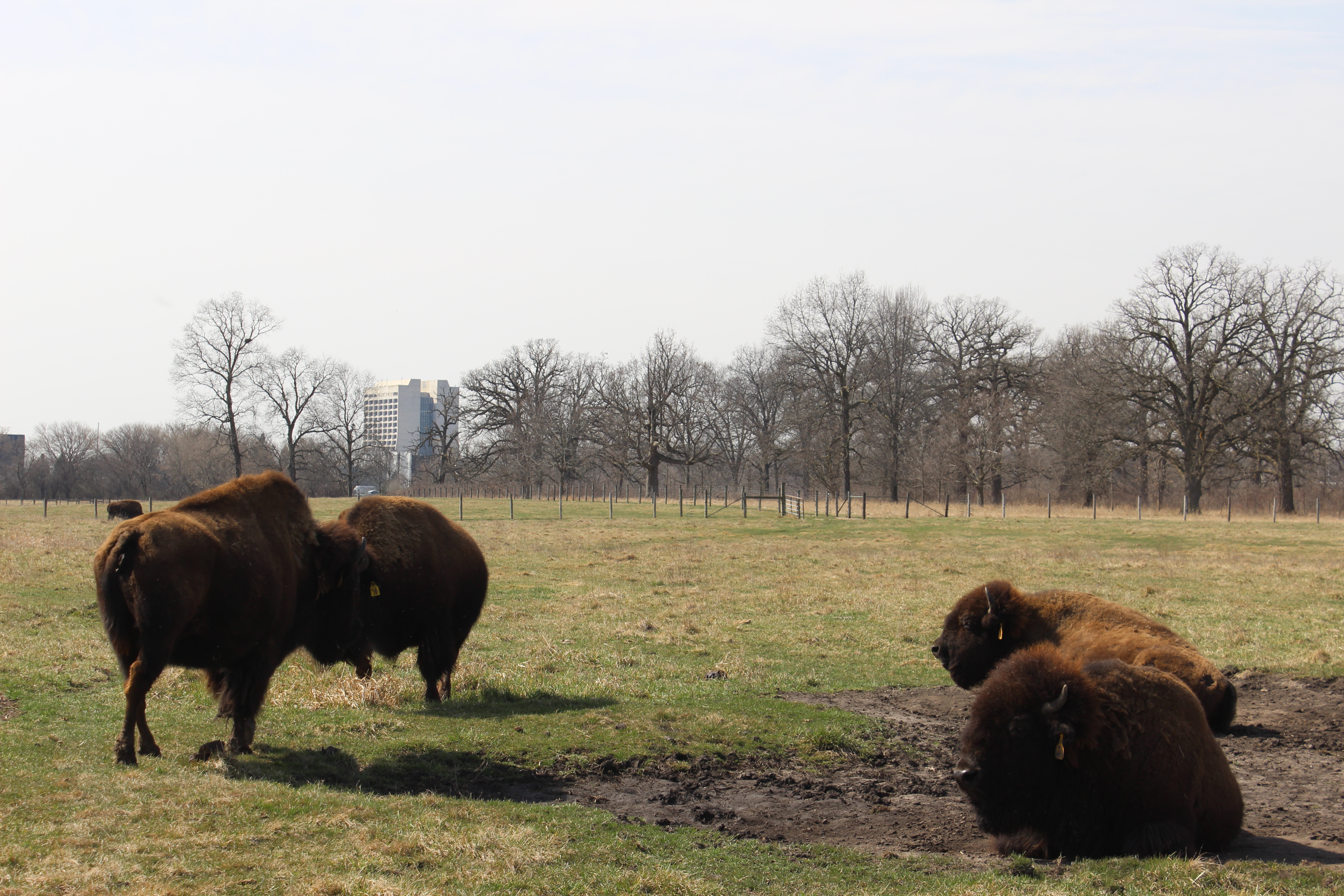Fermilab, the United States’ premier particle accelerator laboratory is filled with neutrino detectors, quantum computers, and an accelerator complex. The most unexpected feature is perhaps not the state-of-the-art equipment, but a small herd of bison that have called the grounds home for most of the lab’s existence.
Located about 35 miles outside of Chicago, this quickly growing suburb is not the first place one might expect to find the large animals. Fermilab, however, is located on historic prairie land, as is most of Illinois. Three hundred years ago, herds of bison found their way to this locale naturally. Now, the restored prairie on the Fermilab campus stands in stark contrast to the developed land around it.
The Fermilab herd’s history started well before its time on the lab campus, when the first colonists shot a bison as part of the Euro-American land grab in the mid-nineteenth century. In the time between then and now, the bison was hunted to the brink of extinction, sectioned into private herds, and immortalized as an icon of the frontier. It was the bison’s symbolic status that inspired the first Fermilab team to add the herd to their newly renovated prairie land as they stood on the edge of their own frontier – the scientific frontier.
The era of the wild bison is long gone, and though the species is no longer threatened with extinction, those bison that do exist are still primarily in private herds – 420,000 of the 450,000 remaining plains bison.
In the whirl of Westward expansion, Manifest Destiny, and the ceaseless quest for more land, white Americans spread across the prairie in the 1800s, pushing out and killing the native people. The killing of the Bison that followed then was both a show of disrespect to the land the settlers had appropriated and a deliberate attempt to separate the native people from an essential facet of their lives.
The drop in bison populations from 1820 to 1890, from tens of millions to less than 1,000, also had a measurable effect on the income, infant mortality rate, and overall nutrition of native people in that region.
The story of the bison does not end with them being slaughtered by rifle shot from the windows of newly built trains as they cut across the American West, nor with the public outcry for their protection at the turn of the 20th Century. Rather, they face new conservation challenges that continue to stem from that initial population decline.
The Fermilab herd continues to exist within the evolving legacy of the America bison. A 2015 genetic test of the herd revealed little to no introgression within their DNA. This information is contextualized by both their position as a historic display herd and by the study of hybridization.
The History of Cattle Gene Introgression
It was during the time when bison numbers were quickly dwindling that private ranchers started their own herds. By the time the public tide turned to protect the bison, these private herds contained almost all the remaining few hundred bison. The only surviving wild bison were speculated to be the Yellowstone herd, which numbered a mere twenty-five at that point.
As a result, almost all bison around today, including those that inhabit government parks, descend from one of five foundational private herds: The Charles Goodnight herd of Texas, the Alloway-McKay herd of Canada, the Dupree-Philip herd of South Dakota, the Pablo-Allard herd of Montana, and the Jones herd of Kansas and Oklahoma.
Most of these five herds experimented by crossing their bison with the various types of cattle on their ranch. The primary reason for doing, according to the rancher’s documentation of their results, so was to create more profitable and sustainable livestock. The Jones herd, for instance, crossed bison with black angus cattle to create a “seal-skin buffalo." Their means to create these ‘cattalo’ however, were more mad-science than lab-safe.

By 1890, the majority of remaining bison were owned by private herds.
In his account of his crossbreeding attempts, for example, Charles Goodnight claims that these hybrids were more tick-resistant, stronger, and more able to gain more weight with less food than average cattle. However, he also noted high birth and calf mortality rates among the first crosses, particularly among male calves. It took multiple generations of hybrids for infant mortality to stabilize.
Goodnight’s statement that his cattalo, “put on flesh faster than any cattle and [lived and appeared to do well] where cattle [would] perish” made clear his ambitions had more to do with improving his own cattle stock than with protecting bison populations.
When the American Bison Society formed in 1905 to take formal action on bison conservation, they had to pull partially from these private herds to populate their first few conservation herds. The first Yellowstone Park conservation herd, for instance, added eighteen bison from the Pablo-Allard herd and three bison from the Goodnight herd to the existing indigenous bison. By the 1960’s virtually every federal herd either directly or indirectly received bison from a private herd.
Cattle crossbreeding in these foundational herds has resulted in what is called Cattle Gene Introgression among nearly all modern American bison. ‘Introgression’ is the presence of genes from one species in the gene pool of another. In this case, domestic cattle genes from Angus, Charolais, Hereford, and Holstein cattle are found in both the mitochondrial and nuclear DNA of bison.
Introgression has two potential implications for bison conservation. The first is the danger of extinction through hybridization. This prompts questions of what defines a bison, and to what extent a bison with cattle genes can still be considered a bison. The fundamental genome of the bison species is no longer the same at a fundamental level.
The second danger is more pertinent to the genetic health of the species. Introgression can affect a herd’s genetic diversity, which is important for disease prevention and high birth rates.
“There’s a lot of issues that come from decreased genetic diversity,” explains Wally Levernier, Fermilab ecologist. “If there’s a disease and it’s introduced into a herd, if they all have the same genes, they’re less likely to have some [genes] that are resistant to whatever disease it is.”
The most recent research from Texas A&M suggests that low levels of introgression are present across most, if not all, of the remaining American bison. The study included 25 bison, all of which represent lineages from the foundational herds, and all presented with some cattle DNA. While these results cannot be generalized to any specific herd that was not tested in this study, it does demonstrate the pertinence of this genetic marker. From this, the research team led by Dr. James Derr and Brian Davis concluded that halting the spread of introgression should no longer be the goal of federal conservation efforts, but rather maintaining genetic diversity in the wake of it.
The human impact on the American bison can be overstated. Not only did European colonists cause the initial population decline as a result of their cruel treatment of Native people and the land. The bison’s continued survival relied on private herds that were managed in a cordance with the profit motive. The result is that as bison populations were bottlenecked through these five ranches, their genetic makeup was irreparably damaged.
The Bison on the Fermilab Grounds
On September 4, 1969 a headline in the Village Crier, Fermilab’s employee newsletter, read “Where the Buffalo Roam.” The blurb announced that later that month, six bison would be transported from Longmouth, Colorado to live on the laboratory grounds – “a strange sight for the ‘city slicker’ or even for the ‘country folk’ in this area."
When the lab’s first director, Robert R. Wilson, decided to bring the bison to Fermilab 55 years ago, the concept of Cattle Gene Introgression was not at the top of his mind. The issue would not even be discovered until 1995. Wilson’s goal was to bring the prairie and the frontier to his laboratory.
Wilson was born on his family’s cattle ranch in Frontier, Wyoming, where he grew up aspiring to be a cowboy. Even as he went on to study physics at UC Berkeley and then Princeton, this love of the prairie and nature would continue to shape his outlook.
In the growing unease brought on by the advent of World War II, Wilson, like many physicists at the time, moved his work to Los Alamos to assist in developing nuclear weaponry. He led the Cyclotron Division and then the Experimental Physics Division.
As a pacifist, Wilson struggled with the decision to enter the project, ultimately deciding to assist the American effort out of the growing fear of Nazism. As soon as he saw the first bomb test, however, Wilson described himself as being “re-awakened from being completely technically oriented."
His time at Los Alamos was the last period during which Wilson ever worked in weapons development. He was a founding member of the Federation of American Scientists and criticized the decision to drop atomic weapons on Japan.
After spending some time as the director of the Laboratory for Nuclear Studies at Cornell University, Wilson became involved in the decision-making surrounding the new National Accelerator Laboratory, now Fermilab, as a vocal critic of the original design. Even though the original design was still used, the Atomic Energy Commission offered Wilson the first directorship for the lab, which he accepted.

Fermilab, the United States’ premier particle accelerator laboratory, is located roughly 35 miles outside of Chicago in Batavia, Illinois.
In a congressional hearing authorizing the building of the lab’s first accelerator, Wilson was asked, “Is there anything connected in the hopes of this accelerator that in any way involves the security of the country?” He responded: “No sir; I do not believe so.” When asked again, he continued, “[Construction of the accelerator] only has to do with the respect with which we regard one another, the dignity of men, our love of culture. It has to do with those things. It has nothing to do with the military. I am sorry."
Wilson planned to use Fermilab to create his vision of a center of science. Part of that vision was to transform the land around the lab. Valerie Higgins, lab archivist and historian, explains that when the site was chosen, most of the surrounding land had long since been turned into farmland.
“[Wilson] was writing to the Atomic Energy Commission that they were taking a conservationist approach to the site and they wanted to allow portions of the site to revert back to something close to their historical past,” she explains. “When you look at the history of the lab in the early days, there’s a lot of frontier imagery and this idea of science being the new frontier.”
In addition to welcoming six bison, the lab under Wilson’s direction converted farmland to natural prairie and landscaped water features to attract migratory birds. They hid much of the machinery and infrastructure and added art and sculptures around the grounds. At this time, Wilson decided that there would be no fences or guarded gates at the site, wanting to encourage those in the surrounding area to visit the grounds for themselves.
The bison are perhaps most exemplary of Wilson’s vision for the lab. As an iconic symbol of the American West, the Fermilab herd is both a way to connect the lab with its prairie roots and a motivation for visitors.
By 1971, the herd numbered 18 after completing a series of planned acquisitions from the State of Illinois. Later that same year, the herd welcomed its first calf.
The size of the herd has fluctuated over the years, but bison have consistently been on site since. While there appear to have been plans for a larger group at one point, Fermilab bison herdsman Cleo Garcia explains that they decided to downsize the herd to keep the number of animals manageable and prevent overgrazing. The Fermilab herd currently has 26 adult bison: two bulls and 24 cows.
The Fermilab Herd Amidst the Growing Legacy of American Bison
The Fermilab team has maintained the herd through intentional but infrequent contact with the animals, explains Garcia. Staff provide hay and grain when the ground is frozen over, vaccinate the bison annually, and come in if they need medical attention.
“We try not to intervene too much,” says Garcia, “They can do it by themselves.”
Roads and grounds manager Will Alvarez explains how they maintain the size and genetic diversity of the herd. Every year, the majority of the calves born, typically around 20, are sold. Every five to seven years, they rotate bulls. The same year that they rotate the bulls they also sell some of the older cows and keep some of the younger calves. This prevents inbreeding amongst the herd.

The cows of the Fermilab herd give birth to an average of 20 calves a year, most of which are sold to other herds.
In 2015, the Fermilab team learned new information about their herd that further entwined them in the ever-evolving story of the American bison. Tail samples submitted to Texas A&M University for genetic testing showed that all 17 of the Fermilab bison at that time had no markers of Cattle Gene Introgression. The testing shows that the majority of genomic contributions to the Fermilab bison come from Wind Cave National Park, Fort Niobrara, and the National Bison Range.
Those in charge of maintaining the bison at Fermilab used this information to inform how they would maintain the herd going forward. Now, instead of buying their bulls from farmers in Wisconsin, Garcia says that they source the most recent two from a group who are able to provide them with pure bison. Without these precautions before the genetic testing, explains Garcia, “we were lucky that they [the herd] didn’t have too much cattle [DNA].”
It is important to note that the most recent research out of Texas A&M may affect these results, as they discovered new genetic markers of introgression in lineages previously thought to be free from hybridization, including Wind Cave National Park. Even given the likelihood that the herd is not entirely introgression-free, the Fermilab herd has a high level of genetic purity when compared to most other bison herds.
But for Fermilab, the genetic purity of the herd is secondary. Lab ecologist Levernier explains that the goal with the Fermilab herd is less for large-scale conservation efforts than to expose the public to bison. He contrasts their work to the work of organizations like the Friends of Nachusa Grasslands, which has a 4,100 acre grasslands preserve used for habitat restoration and species conservation.
On a more general level, he says, when bison as genetically pure as the Fermilab bison are sold off into the general bison populations of different herds, as most of the calves are each year, they can assist in maintaining the overall genetic diversity of those new herds.
From the testimonies of those who work at the lab, the bison today continue to serve a similar mission as was on the mind of Director Wilson when the herd first arrived on the lab campus: to bring a little slice of life back to the prairie – and to invite the surrounding public to share in it.
Located in the Chicago suburbs, Fermilab is surrounded by people who have never seen a bison in person. In this way, the herd acts as an important means to educate people about the historical and modern struggles of the American bison. This herd’s recently uncovered genetic history is a new opportunity to discuss the issue of Cattle Gene Introgression mong bison with a larger audience.
“Bison are something that are part of our natural history but are not really present in natural areas,” says Levernier regarding the fact that many visitors lay eyes on their first bison at Fermilab.
And the impact of seeing a bison in person is real.
Roads and grounds keeper Alvarez describes the impact of seeing a bison in person for the first time: “They’re just a lot bigger in person than what most people think. When you’re actually face to face with them you see how big they really are. For me it was their eyes and how big their eyes actually are once you get close.”
“They’re so powerful,” echoes Higgins, discussing an aspect of the bison she did not expect. “My first impression when I did see how big they were, is that they must be these really slow, lumbering creatures – and they’re not. When you see one of them run or when you see them playing together, they just move so surprisingly quickly for how large they are.”
The bison act as a bridge to garner excitement from the community for both prairie conservation, and the work of Fermilab as a research laboratory.
“At this point, I think they’re so loved it’s just become synonymous with Fermilab,” said lab historian Higgins, “If people know anything about Fermilab, they’ll know that we have bison.”
As Director Wilson first imagined, the restored prairie land and bison herd seem to have successfully softened the edges of the particle accelerator in a way that invites the public to engage with the research of the lab, but to also take an interest in the natural history of their locale. Now, as bison conservation evolves and takes on new challenges, the Fermilab herd’s story grows as their genetics become a new piece of their history.

The Fermilab herd serves as a way for people in the surrounding area to see bison in person.
Conclusion
For many, as for Director Wilson, bison conjure images of wide-open spaces and the prairie as it naturally once was. Seeing their enormity in person makes that image clearer. It also makes one regret their loss, the estimated 30-60 million that used to inhabit the vast landscape, winnowed down to a few hundred.
The story of the bison is irreparably tied to the story of Westward expansion. Evidence of this connection lies not only in the comparatively meager number of the current 450,000 American bison but also in the mixed genetics of those remaining animals. Cattle gene introgression is a form of hybridization so prevalent that the full extent of its impact on the bison genome is difficult to determine. The human damage to the very footprint of the bison is undeniable and irreversible, and perhaps because of that they continue to exist as this larger-than-life symbol of the old frontier.
Fermilab was on the edge of a very different frontier when the team there first brought the bison to live on the laboratory grounds. The 1950s and 60s brought a new public caution towards scientific inquiry. Fear of nuclear power had become so common that school children practiced atom bomb drills in their classrooms. Director Wilson, a decade or so after his moment of realization in the New Mexico desert, now had the opportunity to use science for the purposes he saw fit – “It only has to do with the respect with which we regard one another."
The bison on the Fermilab campus today function similarly to the herd as it was founded 55 years ago. They represent the natural history of the land while inviting the local community to engage in this new frontier. Their genetic history is a new chapter in their story and builds a deeper understanding about how the Fermilab bison connect to the grander tale of the American bison. As every year moves further from the times when the bison roamed the prairie in unimaginable numbers, the Fermilab herd will continue to be the way that many stand in the presence of a bison for the first time.
Allendorf, F. W., Leary, R. F., Spruell, P., & Wenburg, J. K. (2001). The problems with hybrids: Setting conservation guidelines. Trends in Ecology & Evolution, 16(11), 613–622. https://doi.org/10.1016/s0169-5347(01)02290-x
Anonymous. About Fermilab. Fermilab. (n.d.). https://www.fnal.gov/pub/about/index.html
Anonymous. About Friends. Friends of Nachusa Grasslands. (n.d.). https://www.nachusagrasslands.org/
Anonymous. AEC Authorizing Legislation, F. Y. 1970-P. 1. (1969, April). R.R. Wilson’s Congressional Testimony. Fermilab. https://history.fnal.gov/historical/people/wilson_testimony.html
Anonymous. Bison cattle introgressions: Our dirty past. Ozark Valley Bison Farm. (2018). https://www.ozarkbisons.com/introgressions.php
Anonymous. Shawnee National Forest - History & Culture. Forest Service National Website. (n.d.). https://www.fs.usda.gov/detail/shawnee/learning/history-culture/?cid=stelprdb5152179
Anonymous. The Village Crier Vol. 1 No. 4. (1969, September 4). Where the Buffalo Roam. Fermilab. https://history.fnal.gov/historical/site/buffalo_roam.html
Anonymous. The Village Crier Vol. 3 No. 10. (1971, March 11). More Buffalo Arrive at NAL. Fermilab. https://history.fnal.gov/historical/site/more_buffalo.html
Anonymous. The Village Crier Vol. 3 No. 23. (1971, June 10). Second Generation of Buffalo Starts Life on NAL Range. Fermilab. https://history.fnal.gov/historical/site/second_buffalo.html
Anonymous. U.S. Department of the Interior. (n.d.). People and Bison. National Parks Service. https://www.nps.gov/subjects/bison/people.htm
Anonymous. U.S. Fish & Wildlife Service. (n.d.). Plains Bison (BISON BISON BISON). FWS.gov. https://www.fws.gov/species/plains-bison-bison-bison-bison
Boyd, M. M. (1914). Crossing Bison and Cattle. Journal of Heredity, 5(5), 189–197. https://doi.org/10.1093/oxfordjournals.jhered.a107838
Clark, C. (2023, August 23). Buffalo Slaughter left lasting impact on Indigenous Peoples. Emory News Center. https://news.emory.edu/stories/2023/08/esc_bison_impact_24-08-2023/story.html
Dafoe, J. W. (1889). Domestication of the Buffalo. Popular Science Monthly, 34, 777–781.
Haberman, C. (2018, May 13). “this is not a drill”: The threat of nuclear annihilation. The New York Times. https://www.nytimes.com/2018/05/13/us/nuclear-threat-retro-report.html
Halbert, N. D., & Derr, J. N. (2006). A comprehensive evaluation of cattle introgression into US federal bison herds. Journal of Heredity, 98(1), 1–12. https://doi.org/10.1093/jhered/esl051
Hoddeson, L., Kolb, A. W., & Westfall, C. (2011). Fermilab: Physics, the Frontier, and Megascience. University of Chicago Press.
Ploeger, J. S. (2002). The art of science at fermi national accelerator laboratory: The Rhetoric of Aesthetics and humanism in the National Laboratory System in the late 1960s. History and Technology, 18(1), 23–49. https://doi.org/10.1080/07341510290028765
Polziehn, R. O., Strobeck, C., Sheraton, J., & Beech, R. (1995). Bovine mtdna discovered in North American bison populations. Conservation Biology, 9(6), 1638–1638. https://doi.org/10.1046/j.1523-1739.1995.09061638.x
Shaw, J. H. (1995). How Many Bison Originally Populated Western Rangelands? . Rangelands, 17(5), 148–150.
Shivni, Rashmi (2016, January 27). The genetic purity and diversity of the Fermilab Bison Herd. Fermilab. https://news.fnal.gov/2016/01/the-genetic-purity-and-diversity-of-the-fermilab-bison-herd/
Sickel, B. (2018, January 18). The Bison and the rancher. Ranchlands. https://ranchlands.com/blogs/journal/the-bison-and-the-rancher
Stroupe, S., Forgacs, D., Harris, A., Derr, J. N., & Davis, B. W. (2022). Genomic evaluation of hybridization in historic and modern North American Bison (bison bison). Scientific Reports, 12(1). https://doi.org/10.1038/s41598-022-09828-z

